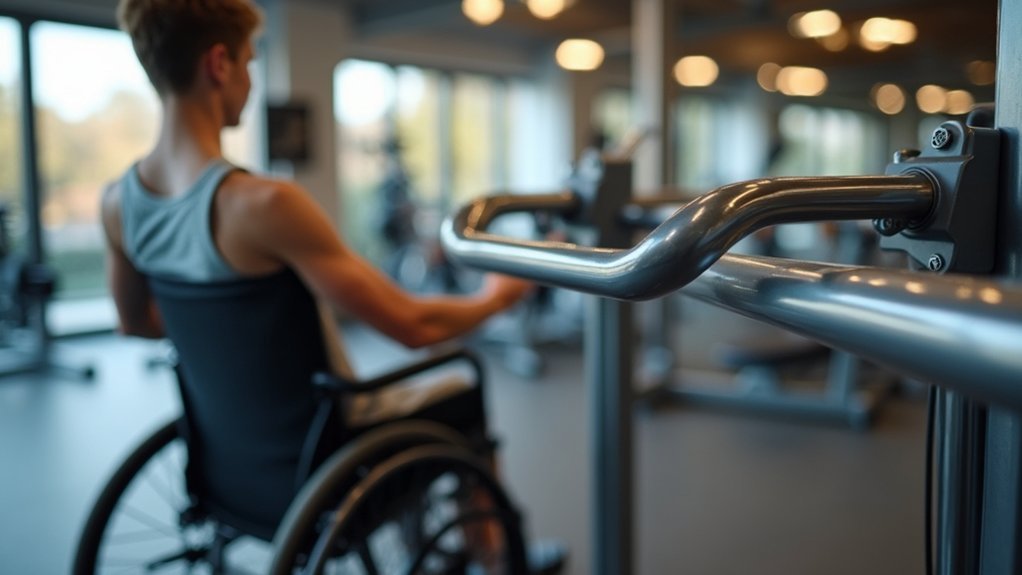Disclaimer: This content is for informational purposes only and does not replace professional medical advice, diagnosis, or treatment. Always consult a qualified healthcare provider before beginning any new exercise program.
You’ll discover that wheelchair-accessible weight racks aren’t just equipment—they’re gateways to inclusive strength training. These innovative designs transform traditional fitness spaces by offering precise height adjustments that accommodate diverse mobility needs. If you’ve ever felt limited by standard gym infrastructure, these adaptive racks promise a revolutionary approach to personal fitness. What makes these systems so unique that they could potentially redefine your entire workout experience? The answer lies in their intelligent, user-centered engineering.
Key Takeaways
- Height-adjustable weight racks ranging from 30 to 54 inches provide critical accessibility for wheelchair users, allowing comfortable and safe strength training.
- Open frame designs with intuitive adjustment mechanisms like pin or knob systems enable quick, tool-free modifications to accommodate individual user needs.
- Integrated locking pins and stabilizing bases ensure equipment safety, allowing wheelchair users to confidently perform strength training exercises independently.
- Multi-point adjustable handles and seats offer comprehensive customization, addressing diverse biomechanical requirements and promoting inclusive fitness experiences.
- Advanced designs incorporate smart technologies like digital interfaces and dynamic resistance sensors to personalize workout intensity and track performance progress.
Ergonomic Design Principles for Adaptive Fitness Equipment

While adaptive fitness equipment demands meticulous design considerations, ergonomic principles serve as the foundational framework for creating inclusive weight racks. You’ll find that height-adjustable features are critical for ensuring accessibility across diverse user needs. The equipment’s design must prioritize multi-point adjustments for handles and seats, allowing precise customization for individual body mechanics and comfort.
Your adaptive weight rack should integrate adjustable components that accommodate wheelchair users, enabling seamless changes and modifications. By implementing intuitive height-adjustment mechanisms, you’ll create equipment that responds dynamically to users’ specific physical requirements. These ergonomic principles aren’t just technical specifications—they’re essential strategies for promoting independence and inclusivity in fitness environments, ensuring that every user can engage with exercise equipment safely and confidently.
Key Features of Height-Adjustable Weight Racks

Height-adjustable weight racks represent a critical advancement in adaptive fitness technology, offering three primary ergonomic design elements that revolutionize accessibility. You’ll find these racks feature precise height ranges from 30 to 54 inches, enabling wheelchair-accessible fitness experiences across diverse user needs. The adjustment mechanisms—typically utilizing simple pin or knob systems—allow rapid, tool-free height modifications, ensuring seamless shifts between standing and seated exercise configurations.
Critically, these weight racks incorporate open frame designs that facilitate wheelchair user maneuverability. Safety remains paramount, with integrated locking pins and stabilizing bases providing robust support during intense training sessions. By prioritizing height customization and structural integrity, these adaptive weight racks transform fitness equipment from restrictive to inclusive, empowering individuals with mobility challenges to engage in thorough strength training routines.
Benefits of Wheelchair-Accessible Strength Training Solutions

Because adaptive fitness technology continues to evolve, wheelchair-accessible strength training solutions now offer unprecedented opportunities for individuals with mobility challenges to achieve extensive physical conditioning. These innovative systems provide wheelchair users with critical ergonomic advantages through Adjustable Height features that minimize physical strain and maximize workout potential.
| Benefit | Impact |
|---|---|
| Muscle Strength | Enhanced muscular development |
| Joint Stability | Reduced injury risk |
| Workout Comfort | Optimized exercise engagement |
| Physical Independence | Increased self-confidence |
Customization Options for Individual User Needs

Wheelchair-accessible weight racks represent a paradigm shift in adaptive fitness equipment, with customization options that precisely address individual user biomechanics and mobility requirements. These innovative exercise equipment solutions enable wheelchair users to optimize their strength training experience through highly personalized configurations.
Adaptive fitness equipment revolutionizes strength training for wheelchair users through precision-engineered, biomechanically tailored design solutions.
Key customization features include:
- Height-adjustable mechanisms allowing seamless alignment with user’s seated position
- Modular weight storage components facilitating easy weight transfer
- Adaptable side access points accommodating diverse wheelchair designs
Technology and Innovation in Adaptive Exercise Equipment

As adaptive fitness technology evolves, innovative engineering transforms wheelchair-user exercise equipment through sophisticated design principles and advanced technological integrations. You’ll find cutting-edge weight racks featuring digital interfaces that allow precise workout customization, facilitating users to track performance metrics and adjust resistance settings effortlessly. The modular construction guarantees easy storage and simple put together configurations, accommodating diverse user requirements.
Ergonomic innovations now incorporate smart sensors and programmable resistance mechanisms that adapt dynamically to individual strength levels and rehabilitation goals. These technological enhancements aren’t just aesthetic improvements—they represent a fundamental reimagining of accessibility in fitness equipment. By integrating high-performance materials with intelligent design principles, manufacturers are creating weight racks that provide unprecedented flexibility, safety, and user-centric functionality for wheelchair athletes and fitness enthusiasts.
Frequently Asked Questions
How Much Weight Can a Wheelchair-Accessible Rack Typically Support?
You’ll find most wheelchair-accessible weight racks support 300-500 pounds, with adaptive design ensuring stability. The weight capacity depends on material strength, structural engineering, and precise ergonomic considerations for safe, inclusive strength training environments.
Are These Racks Compatible With Multiple Wheelchair Dimensions?
Ever wondered about wheelchair-friendly fitness gear? These universal design racks, shaped by user feedback, offer adjustable widths and heights to accommodate diverse wheelchair dimensions, ensuring an ergonomic, inclusive strength training experience.
What Maintenance Is Required for Height-Adjustable Fitness Equipment?
You’ll need to perform routine checks on adjustable mechanisms, lubricating moving parts quarterly, inspecting structural integrity, and ensuring smooth height changes. Regular maintenance prevents wear, maintains precision, and guarantees safe, reliable performance of your height-adjustable fitness equipment.
Can Standard Gym Accessories Be Used With Adaptive Racks?
You’ll need specialized adaptive accessories designed for gym inclusivity. Standard equipment may not align ergonomically with height-adjustable racks. Consult manufacturer specifications to verify compatibility, safety, and peak performance for diverse user needs and functional training requirements.
How Expensive Are Wheelchair-Accessible Weight Training Systems Compared to Traditional Racks?
Like Rocky’s climb to fitness, you’ll find wheelchair-accessible weight systems cost 20-50% more than traditional racks. Your equipment investment reflects advanced ergonomic design, specialized engineering, and customizable height adjustments for thorough adaptive training needs.
Conclusion
You’ll open up a world of strength and empowerment with wheelchair-accessible weight racks. Like a Swiss Army knife of fitness, these adaptable platforms slice through barriers, transforming limitations into opportunities. Engineered with precision and human-centered design, they’re not just equipment—they’re freedom mechanisms. By embracing height-adjustability and inclusive technology, you’re not just lifting weights; you’re elevating potential, one customized, ergonomic adjustment at a time.



